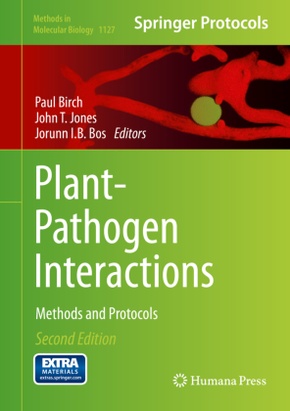
Plant-Pathogen Interactions - Methods and Protocols
| Verlag | Springer |
| Auflage | 2014 |
| Seiten | 306 |
| Format | 18,1 x 26,0 x 2,1 cm |
| Gewicht | 754 g |
| Artikeltyp | Englisches Buch |
| Reihe | Methods in Molecular Biology 1127 |
| EAN | 9781627039857 |
| Bestell-Nr | 62703985UA |
Plant-Pathogen Interactions: Methods and Protocols, Second Edition expands upon the first edition with current, detailed protocols for the study of plant pathogen genome sequences. It contains new chapters on techniques to help identify and characterize effectors and to study their impacts on host immunity and their roles in pathogen biology. Additional chapters focus on protocols to identify avirulence and resistance genes, investigate the roles of effector targets and other defence-associated proteins in plant immunity. Written in the highly successful Methods in Molecular Biology series format, chapters include introductions to their respective topics, lists of the necessary materials and reagents, step-by-step, readily reproducible laboratory protocols and tips on troubleshooting and avoiding known pitfalls.
Authoritative and cutting-edge, Plant-Pathogen Interactions: Methods and Protocols, Second Edition seeks to aid scientists in the further study of plant immunity.
Inhaltsverzeichnis:
Galaxy as a Platform for Identifying Candidate Pathogen Effectors.- Bioinformatic analysis of expression data to identify effector candidates.- Two-dimensional data binning for the analysis of genome architecture in filamentous plant pathogens and other eukaryotes.- On The Statistics Of Identifying Candidate Pathogen Effectors.- High-throughput imaging of plant immune responses.- In vivo protein-protein interaction studies with BiFC: conditions, cautions and caveats.- Particle bombardment-mediated transient expression to identify localization signals in plant disease resistance proteins and target sites for the proteolytic activity of pathogen effectors.- Purification of fungal haustoria from infected plant tissue by flow cytometry.- Functional Characterisation of Nematode Effectors in Plants.- Silencing of aphid genes by feeding on stable transgenic Arabidopsis thaliana.- Leaf-disc assay based on transient over-expression in Nicotiana benthamiana to allow functional screening of candidate effectors from aphids.- A growth quantification assay for Hyaloperonospora arabidopsidis isolates in Arabidopsis thaliana.- Simple quantification of in planta fungal biomass.- Virus-induced gene silencing and Agrobacterium tumefaciens-mediated transient expression in Nicotiana tabacum.- DIGE-ABPP by click chemistry: Pairwise comparison of serine hydrolase activities from the apoplast of infected plants.- A Simple and Fast Protocol for the Protein Complex Immunoprecipitation (Co-IP) of Effector - Host Protein Complexes.- An Arabidopsis and Tomato Mesophyll Protoplast System for fast Identification of early MAMP-triggered Immunity-Suppressing Effectors.- Production of RXLR effector proteins for structural analysis by X-ray crystallography.- The Do's and Don'ts of effectoromics.- Protoplast cell death assay to study Magnaporthe oryzae AVR gene function in rice.- A Bacterial Type III Secretion Based Delivery System for Functional Assays of Fungal Effectors in Cereals.-Ca pture arrays to annotate resistance genes in plant genomes and to accelerate plant resistance gene discovery.
